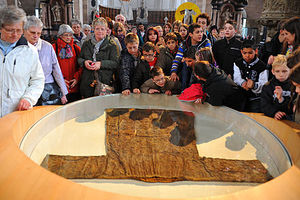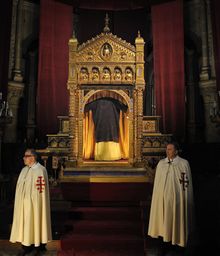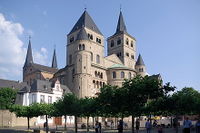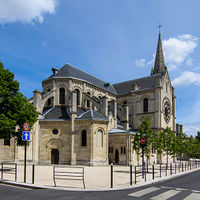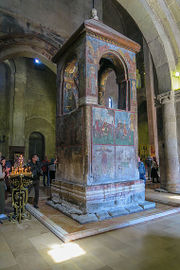Category:Holy Robe (subject)
According to Christian traditions, the Holy Robe are the Mantle and the Tunic Jesus wore at his crucifixion.
Overview
According to the Gospel of John, the soldiers who crucified Jesus divided his himatia (mantle) "into four piece" but cast lots to determine who would keep his chiton (tunic) because it was woven in one piece, without seam (John 19:23-24; cf. LXX Psalm 21 [22]:18-19). The Mantle (himatia) and the Tunic (chiton) are then two separate relics. Both of them are said to have been preserved by the Church. And yet, two different traditions are told in the West or in the East about their "recovery".
Western traditions
The possession of the seamless tunic of Jesus is claimed by the Cathedral of Trier [Germany] and by the parish church of Argenteuil [France]. While both Tier and Argenteuil claim to possess the authentic seamless robe of Jesus, attempts have been made to harmonize the two traditions by suggesting that one of the two could actually be the Mantle, and the other the Tunic of Jesus.
(a) The Trier Robe
A tradition of the Latin Church holds that the seamless robe that Jesus wore at his crucifixion was rediscovered in the 4th century at Jerusalem by Helena, the mother of Emperor Constantine, and brought in 328 CE to Tier [Germany]], where the relic is still housed in the Cathedral.
The earliest historical record of the presence of the Holy Robe at Trier Cathedral comes from 1196. As in the case of most medieval relics, it is very difficult to say more about its origin. An independent scientific examination of the specimen has not been conducted.
The pilgrimage dates to 1512, when Holy Roman Emperor Maximilian I demanded a personal viewing of the Holy Robe. This led to demands from lay citizens to see the relic and pilgrimages to the robe began.
The pilgrimage caused controversy in 1844, when it was used as an opportunity for Catholics to assert their identity against Protestant rule. It also sparked conflict within the Catholic Church. Claims that the robe had healing properties angered some faithful, who broke away from the Roman Catholic Church, calling themselves the New Catholics (later the German Catholics).
Today, the relic is displayed to the visitors only in special occasions, the last times in 1933, 1959, 1996, and 2012. Since 1959, the diocese of Trier started to bring an ecumenical dimension to the pilgrimage, adopting the motto: “And join together what is separated.” Protestant and Orthodox Christians were invited to join some events, lectures and prayer services.
(b) The Argenteuil Robe
Another tradition links the seamless robe to the Benedictine monastery of Argenteuil [France], as a gift of the Emperess Irene to Charlemagne. The earliest document from the 12th century describes the relict as the garment of the child Jesus, which however was believed to have grown miraculously with him during his entire life.
In the aftermath of the French Revolution, the monastery of Argenteuil was destroyed and allegedly the local parish priest in order to hide the relic cut it into many pieces of which only four survived and were moved in 1865 to the present church of Argenteuil. The relic was apparently stolen in 1983 but soon recovered. The last solemn expositions of the tunic was held during Easter 1984 and 2016.
Eastern traditions
According to an Eastern Orthodox tradition, the soldier who acquired the Lord’s Robe was Georgian and subsequently brought it back to his country. According to another account, a community of Jewish immigrants had settled in Iberia (Georgia) during the Babylonian captivity; their descendents lived in Mtskheta, the ancient capital of Iberia. The Jews of Mtskheta sent envoys to Jerusalem each year to participate in the celebration of Passover. One of them, named Elioz, witnessed the suffering of Jesus Christ on Golgotha and came to believe in Him. He was able to acquire the Lord’s Robe from the soldier who had won it by lot; he then returned with it to Mtskheta.
Portions of Jesus’ clothing are preserved in the crypt of the Patriarchal Svetitskhoveli Cathedral in Mtskheta, Georgia where the feast day in honor of the Chiton of the Lord is celebrated on October 1.
When the Persian Shah Abbas I conquered Georgia in 1616-1617, Tsar Mikhail Fydorovich of Russia took King Teimuraz of Georgia under his protection by the latter’s request. In 1622, during negotiations on the future of Georgia and King Teimuraz, the Shah informed the Russian envoy that he was in possession of the Lord’s Chiton, which he claimed to have seized in Georgia, and that he intended to send it to Moscow, to Tsar Mikhail Fyodorovich and Patriarch Philaret Nikitich. Shah Abbas was true to his word: in March 1625 the Persian ambassador Urusambek brought the Precious Robe to Moscow. After a series of miracles confirmed the authenticity of the relic, the solemn deposition of the Precious Robe in the Dormition Cathedral of the Moscow Kremlin took place on March 27, 1625.
Over time, fragments of the Robe were distributed to Saint Petersburg, Kiev, and other monasteries, and even to some noble families. The portion remaining in Moscow continued to be brought out annually for veneration at the Dormition Cathedral.
Today, the Russian Orthodox Church commemorates the Placing of the Honorable Robe of the Lord at Moscow on July 10 (July 25). At Moscow annually on that day, the robe is solemnly brought out of the chapel of the Apostles Peter and Paul at the Dormition cathedral, and it is placed on a stand for veneration by the faithful during the divine services.
Modern legends
The legend of the Holy Robe inspired in 1942 a novel by Lloyd C. Douglas, and in 1953 a movie, directed by Henry Koster, with Richard Burton, Jean Simmons, and Victor Mature.
External links
- The Lord's Robe in Russia
- The Holy Robe, Huffington Post (Apr 18, 2012)
- Catholic Encyclopedia
- Wikipedia
Pages in category "Holy Robe (subject)"
The following 2 pages are in this category, out of 2 total.
Media in category "Holy Robe (subject)"
The following 3 files are in this category, out of 3 total.
- 1942 * Douglas (novel).jpg 375 × 499; 35 KB
- 1953 * Koster (film).jpg 325 × 496; 85 KB
- 1954 Daves (film).jpg 285 × 395; 37 KB
